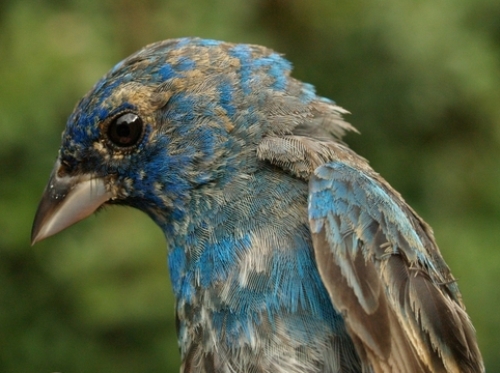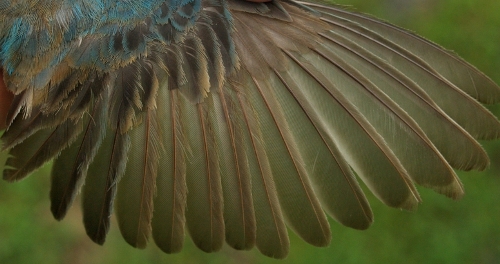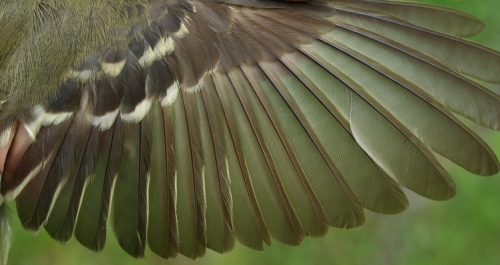|
Week 2: August 8-14, 2010 |
Welcome
to the McGill Bird Observatory weekly report.
Click here for a complete listing of our archives.
Comments or
questions are welcome at "mbo AT migrationresearch.org".
|
PICTURE
OF THE WEEK: |
|

A rather young Brown Thrasher, undergoing moult on the breast, and with a distinctly pale iris.
(Photo by Simon Duval)

|
MBO
gratefully acknowledges the fundraising efforts of CCFA (Centre de Conservation de la Faune Ailée) in support of MBO - drop in at the store or click on the logo at left to visit the website for details on bird posters for sale with proceeds benefiting MBO.
|
|
|
|
THIS WEEK |
THIS FALL |
2010 TOTAL |
SITE TOTAL |
|
# birds (and species) banded |
192 (34) |
442 (42) |
1317 (66) |
24826 (105) |
|
# birds (and species) repeat |
39 (17) |
74 (21) |
288 (36) |
4629 (66) |
|
# birds (and species) return |
2 (2) |
8 (7) |
140 (28) |
760 (37) |
|
# species observed |
68 |
82 |
144 |
202 |
|
# net hours |
558.0 |
1026.0 |
4585.4 |
44492.6 |
|
# birds banded / 100 net hours |
34.4 |
43.1 |
28.7 |
55.8 |
|
|
Note: table does not include nocturnal banding (owls) |
|
Bander-in-charge: Simon Duval
Assistants: Jean Demers, Leah Den Besten, Andree-Anne Deschamps, Benoit Duthu, Rejean Duval, Nicki Fleming, Alain Goulet, Gay Gruner, Marie-Anne Hudson, Marie-France Julien, Barbara MacDuff, Chris Murphy, Clémence Soulard, Audrey Speck, Patricia Stotland, Dara Thompson, Rodger Titman
Notes: The strong start to this year's fall migration continued this week, with the total of 191 birds banded the second highest for this period over the past six years, and the cumulative total of 441 for the first two weeks far ahead of the previous record of 377. Interestingly though, diversity is down, with the 68 species observed this week and the 82 to date for the season the lowest ever for week 2. However, for the second week in a row, a new species was added to the MBO site checklist, this time a couple of Common Terns flying overhead.
Other species observed for the first time this fall were Canada Goose, Broad-winged Hawk, Red-tailed Hawk, Cooper's Hawk, Merlin, Belted Kingfisher, Winter Wren, Red-breasted Nuthatch, Brown Thrasher, Yellow-rumped Warbler, and Eastern Towhee; the towhee was also new for the year, and a good sighting in that we don't encounter it annually. Among birds banded, we had our first Downy Woodpecker of the year, and our first Warbling Vireo, Brown Thrasher, Common Grackle, and American Goldfinch of fall. We had just two returns this week, but one was particularly interesting, a Chestnut-sided Warbler that we banded on August 8, 2009 and haven't encountered since. Given that Chestnut-sided Warblers generally aren't present at MBO in summer, this individual is making some effort to return to MBO each August.

To illustrate last week's comment about each Indigo Bunting in fall looking a bit different, here's another male from this week, this time a second-year bird, as evident through the retained juvenile feathers on the wing, as shown below (the primary coverts, inner primaries, and outer secondaries).
(Photos by Simon Duval)

|
We received news this week from the banding office that an American Redstart we banded at MBO on September 2, 2005 as a hatch-year bird was reported from Laval on May 18, 2010. Unfortunately it was found dead (likely a building strike), but all the same it marks an interesting record.
|
This week’s top 10
[last week's rank in brackets]
|
# individuals banded |
mean # individuals observed daily |
|
1. Song Sparrow (49) [1] |
1. American Crow (19.6)
[6] |
|
2. Common Yellowthroat (14) [9] |
2. Black-capped Chickadee (17.6) [3] |
|
2. American Redstart (14)
[3] |
3. Song Sparrow (13.4)
[4] |
|
4. Yellow Warbler (10)
[2] |
4. American Goldfinch (12.4)
[7] |
|
5. Red-eyed Vireo (9) [8] |
5. Cedar Waxwing (9.7)
[1] |
|
6. Indigo Bunting (8) [-] |
6. Common Grackle (8.0) [5] |
|
7. Cedar Waxwing (7)
[5] |
7. American Robin (7.9)
[2] |
|
8. Tennessee Warbler (6) [10] |
8. Gray Catbird (6.1) [-] |
|
9. Downy Woodpecker (5)
[-] |
9. Indigo Bunting (5.9) [9] |
|
9. Traill's Flycatcher (5) [-] |
9. Northern Cardinal (5.9)
[-] |
9. Black-capped Chickadee (5) [6] |
|
9. Veery (5) [-] |
|
9. Ovenbird (5) [-] |
|
|
As usual, Song Sparrows are continuing to dominate the banding totals - this is the fourth time in the past five years that they have been number one for both weeks 1 and 2. American Redstart and Yellow Warbler are also regularly among the most banded species for week 2, but the surprise is Common Yellowthroat, which has never previously ranked higher than 7th for this week, and in three of five previous years didn't even rank in the top 10 for this week. Yellowthroats usually peak toward late August and into September, so it will be interesting to see whether they are simply early this year, or much larger numbers are yet to come. The highest ranking newcomer to the list this week is Indigo Bunting; it and Ovenbird are both in the top 10 for week 2 for the third time in six years. Traill's Flycatcher has made the list for five years running now, while the final new species for the week, Veery, makes its first ever appearance in the top ten banded list in any season.
Among the species observed, the top seven are the same as last week, but shuffled around with Cedar Waxwing and American Robin dropping considerably, and American Crow jumping up into top place. Common Grackle was the top bird in week 2 for the past two years, but was not particularly dominant this week. Indigo Bunting remained in the top ten for a second straight week, while Northern Cardinal made its first ever fall appearance in the top ten.
|

In fall we are often limited to classifying birds as hatch-year of after-hatch-year, but especially in August, we sometimes can still separate second-year birds from the mix. Such is the case with this Yellow-bellied Flycatcher, showing retained juvenile outer greater coverts, primary coverts, inner primaries, and outer secondaries.
(Photo by
Simon Duval)

|






